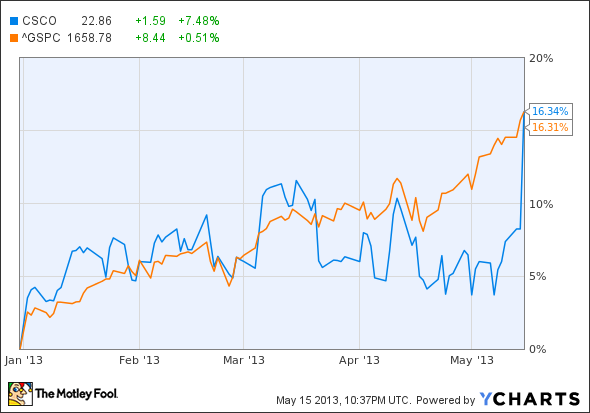The rhythm of daily stock market gains is almost becoming monotonous. Today, U.S. stocks recorded their ninth "up" day in 10 sessions (each of which produced a record (nominal) high in the process), as the S&P 500 (^GSPC +0.67%) and the narrower, price-weighted Dow Jones Industrial Average (^DJI +1.05%) rose 0.5% and 0.4%, respectively.
Today's gains didn't impress option traders, however, as the VIX Index (^VIX 6.85%), Wall Street's fear gauge, rose slightly, to close at 12.81. (The VIX is calculated from S&P 500 option prices and reflects investor expectations for stock market volatility over the coming 30 days.)
Cisco gets some love -- finally
After the market closed on Wednesday, the world's largest networking equipment manufacturer and Dow component Cisco Systems (CSCO +0.93%) reported results for its fiscal third quarter ended April 27. Investors liked what they heard and sent the stock up more than 7% in the after-hours session, which was enough to push the shares' year-to-date performance past that of the S&P 500:
Let's start with a caveat: The after-hours session attracts few participants and is illiquid -- therefore, prices may not reflect the broad market's reception of the new information the following day. However, a glance at Cisco's fundamentals and its valuation suggest these after-hours gains are easily sustainable; in fact, I think this report could be the catalyst for a further rerating of the shares.
What did investors like about the report? Excluding unusual items (which include stock-based compensation -- a routine practice at technology companies), Cisco earned $0.51 per share in the quarter, two cents over the consensus estimate. Meanwhile, revenues of $12.22 billion were also above analysts' expectations of $12.18 billion.
Considering that Cisco peers Juniper Networks and IBM put up weak numbers recently, Cisco is providing investors with evidence that their shift from "being a communications company, a networking company, to more of an IT company" (in the words of CEO John Chambers) was a smart strategic choice.
With shares sporting a 3.2% dividend yield and trading at less than 10.5 times the estimate of next 12 months' earnings per share (based on the $21.21 regular session closing price), it's hardly absurd to think the after-hours price gains will hold and that the shares will go on to outperform the market by a healthy margin.







